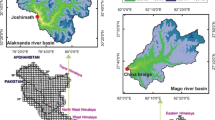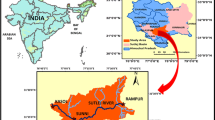Abstract
Climatic and hydrological changes of the scarcely gauged mountainous basins remain a challenge to study due to unavailability of observed data. The recent study aims to assess these changes using spatial decision tool statistical downscaling method (SDSM) and snowmelt runoff model (SRM) for the twenty-first century under representative concentration pathways (RCPs). SDSM considered absolute partial correlation coefficient (abs. Pr.) to evaluate efficiency predictors or the predictands of the Jhelum river basin. The performance evaluation of SDSM assessed using coefficient of determination (R2) values for RCP 4.5 and RCP 8.5 under CMIP5 (CCSM4). The biases of the daily time series downscaled data removed by using mean-based biased correction method (MB-BC). Stream projection carried out using SRM by incorporating MODIS snow product. Statistical parameters R2 and volume difference (Dv %) calculated for accuracy assessment of SRM for the simulated and observed discharge (2001–2018). Streamflow projections for the twenty-first century carried out by SRM using de-biased downscaled data. The R2 indicator of SDSM ranged between 78–81% for temperature and 82–86% for precipitation under RCP 4.5 and RCP 8.5, respectively. The temperature results indicated an increasing trend of 1.5oC and 3.8oC for the twenty-first century under RCP 4.5 and RCP 8.5, respectively. The mean annual precipitation showed a rise of 2–7% while surface runoff projected a rising trend of 3.3–7.4% for RCP-4.5 and RCP-8.5 respectively till the end of the twenty-first century. The study results revealed that Jhelum basin will be wetter and warmer for the twenty-first century as compare to the baseline period. The hydrographs of the river predicted the occurrence of more extreme events in the region for the twenty-first century. These hydrographs may help for better water conservation and management strategies in the Jhelum basin for the twenty-first century.







Similar content being viewed by others
Data availability
In this research, available conventional and modern data sources have been used (sources mentioned) and scientific techniques have been applied on these data sets for research at the local level.
References
Abbasnia M, Toros H (2016) Future changes in maximum temperature using the statistical downscaling model (SDSM) at selected stations of Iran. Modeling Earth Systems and Environment 2(2). https://doi.org/10.1007/s40808-016-0112-z
Adham A, Wesseling JG, Abed R, Riksen M, Ouessar M, Ritsema CJ (2019) Assessing the impact of climate change on rainwater harvesting in the Oum Zessar watershed in Southeastern Tunisia. Agricultural Water Management 221(May):131–140. https://doi.org/10.1016/j.agwat.2019.05.006
Adnan, M., Nabi, G., Kang, S., Zhang, G., Adnan, R. M., Anjum, M. N., … Ali, A. F. (2017). Snowmelt runoff modelling under projected climate change patterns in the Gilgit river basin of northern Pakistan. Polish Journal of Environmental Studies, 26(2), 525–542. 10.15244/pjoes/66719
Ali S, Li D, Congbin F, Khan F (2015) Twenty first century climatic and hydrological changes over Upper Indus Basin of Himalayan region of Pakistan. Environmental Research Letters 10(1). https://doi.org/10.1088/1748-9326/10/1/014007
Azmat M, Qamar MU, Huggel C, Hussain E (2018) Future climate and cryosphere impacts on the hydrology of a scarcely gauged catchment on the Jhelum river basin, Northern Pakistan. Science of the Total Environment 639:961–976. https://doi.org/10.1016/j.scitotenv.2018.05.206
Baek HJ, Lee J, Lee HS, Hyun YK, Cho C, Kwon WT, Marzin C, Gan SY, Kim MJ, Choi DH, Lee J, Lee J, Boo KO, Kang HS, Byun YH (2013) Climate change in the 21st century simulated by HadGEM2-AO under representative concentration pathways. Asia-Pacific Journal of Atmospheric Sciences 49(5):603–618. https://doi.org/10.1007/s13143-013-0053-7
Chu JT, Xia J, Xu CY, Singh VP (2010) Statistical downscaling of daily mean temperature, pan evaporation and precipitation for climate change scenarios in Haihe River, China. Theoretical and Applied Climatology 99(1–2):149–161. https://doi.org/10.1007/s00704-009-0129-6
Elias E, Rango A, Steele CM, Mejia JF, Baca R, James D, Schrader S, Gronemeyer P (2016) Simulated impact of climate change on hydrology of multiple watersheds using traditional and recommended snowmelt runoff model methodology. Journal of Water and Climate Change 7(4):665–682. https://doi.org/10.2166/wcc.2016.097
Hassan Z, Shamsudin S, Harun S (2014) Application of SDSM and LARS-WG for simulating and downscaling of rainfall and temperature. Theoretical and Applied Climatology 116(1–2):243–257. https://doi.org/10.1007/s00704-013-0951-8
Huang J, Zhang J, Zhang Z, Xu CY, Wang B, Yao J (2011) Estimation of future precipitation change in the Yangtze River basin by using statistical downscaling method. Stochastic Environmental Research and Risk Assessment 25(6):781–792. https://doi.org/10.1007/s00477-010-0441-9
Jin H, Ju Q, Yu Z, Hao J, Gu H, Gu H, Li W (2019) Simulation of snowmelt runoff and sensitivity analysis in the Nyang River Basin, southeastern Qinghai-Tibetan Plateau, China. Natural Hazards 0123456789:931–950. https://doi.org/10.1007/s11069-019-03784-0
Keteklahijani, V. K., Alimohammadi, S., & Fattahi, E. (2019). Predicting changes in monthly streamflow to Karaj dam reservoir, Iran, in climate change condition and assessing its uncertainty. Ain Shams Engineering Journal, (xxxx). https://doi.org/10.1016/j.asej.2018.11.004
Khairul, M., Shamsuddin, N., Nor, W., Sulaiman, A., Ramli, M. F., Kusin, F. M., & Sefie, A. (2019). Advances in sustainable and environmental hydrology, hydrogeology, hydrochemistry and water resources. https://doi.org/10.1007/978-3-030-01572-5
Latif, Y., Ma, Y., Ma, W., Sher, M., & Muhammad, Y. (2019). No Title. Snowmelt runoff simulation during early 21st century using hydrological modelling in the snow-fed terrain of Gilgit river basin (Pakistan). https://doi.org/10.1007/978-3-030-01572-5_18
Mahmood R, Babel MS (2013) Evaluation of SDSM developed by annual and monthly sub-models for downscaling temperature and precipitation in the Jhelum basin, Pakistan and India. Theoretical and Applied Climatology 113(1–2):27–44. https://doi.org/10.1007/s00704-012-0765-0
Mahmood R, Babel MS (2014) Future changes in extreme temperature events using the statistical downscaling model (SDSM) in the trans-boundary region of the Jhelum river basin. Weather and Climate Extremes 5(1):56–66. https://doi.org/10.1016/j.wace.2014.09.001
Mahmood R, Babel MS, Jia S (2015) Assessment of temporal and spatial changes of future climate in the Jhelum river basin, Pakistan and India. Weather and Climate Extremes 10:40–55. https://doi.org/10.1016/j.wace.2015.07.002
Mahmood R, Jia S (2016) Assessment of impacts of climate change on the water resources of the transboundary Jhelum River Basin of Pakistan and India. Water (Switzerland) 8(6). https://doi.org/10.3390/W8060246
Mandal S, Breach PA, Simonovic SP (2016) Uncertainty in precipitation projection under changing climate conditions: a regional case study. American Journal of Climate Change 05(01):116–132. https://doi.org/10.4236/ajcc.2016.51012
Martinec, J., Rango, A., & Roberts, R. (1998). Snowmelt runoff model ( SRM ) User ’ s Manual (Updated Edition 1998). 177.
Pervez MS, Henebry GM (2014) Projections of the Ganges-Brahmaputra precipitation-downscaled from GCM predictors. Journal of Hydrology 517:120–134. https://doi.org/10.1016/j.jhydrol.2014.05.016
Rasul G, Mahmood T, Zaman Q, Cheema SB (2012) Validation of APHRODITE precipitation data for humid and sub humid regions of Pakistan. Pakistan Journal of Meteorology 9(17):57–69
Salzmann N, Frei C, Vidale PL, Hoelzle M (2007) The application of Regional Climate Model output for the simulation of high-mountain permafrost scenarios. Global and Planetary Change 56(1–2):188–202. https://doi.org/10.1016/j.gloplacha.2006.07.006
Sharma V, Mishra VD, Joshi PK (2012) Snow cover variation and streamflow simulation in a snow-fed river basin of the Northwest Himalaya. Journal of Mountain Science 9(6):853–868. https://doi.org/10.1007/s11629-012-2419-1
Sharma V, Mishra VD, Joshi PK (2013) Implications of climate change on streamflow of a snow-fed river system of the Northwest Himalaya. Journal of Mountain Science 10(4):574–587. https://doi.org/10.1007/s11629-013-2667-8
Solomon, S., Qin, D., Manning, M., Chen, Z., Marquis, M., Averyt, K. B., … Miller, H. L. (2007). IPCC honoured with the 2007 Nobel Peace Prize REPORTS-ASSESSMENT REPORTS IPCC Fourth Assessment Report (AR4) Climate Change 2007: The Physical Science Basis Contribution of Working Group I to the Fourth Assessment Report of the Intergovernmental Panel on. Lic.Wisc.Edu. Retrieved from http://www.ipcc.ch/publications_and_data/publications_ipcc_fourth_assessment_report_wg...
Tahir, A. A., Hakeem, S. A., Hu, T., Hayat, H., & Yasir, M. (2017). Simulation of snowmelt-runoff under climate change scenarios in a data-scarce mountain environment. International Journal of Digital Earth, 0(0), 1–21. https://doi.org/10.1080/17538947.2017.1371254
van Vuuren DP, Edmonds J, Kainuma M, Riahi K, Thomson A, Hibbard K, Hurtt GC, Kram T, Krey V, Lamarque JF, Masui T, Meinshausen M, Nakicenovic N, Smith SJ, Rose SK (2011) The representative concentration pathways: An overview. Climatic Change 109(1):5–31. https://doi.org/10.1007/s10584-011-0148-z
Acknowledgements
The authors would like to acknowledge Pakistan Meteorological Department (PMD) and Water and Power Development Authority (WAPDA) for access to the meteorological and hydrological data. We would like to acknowledge Canadian climate center and National snow and ice data center for free data sets. We would like to acknowledge NARC, Pakistan (national agriculture research council) for the ASTER GDEM (30m) data. The author would like to thank the University of Gujrat for financial support and PMAS arid agriculture university, Rawalpindi for accommodating me to carry doctoral research.
Funding
No external funding agency involved in the research.
Author information
Authors and Affiliations
Contributions
The article is the part of doctoral research by the primary author (Saira Munawar). The research is supervised by the second (Muhammad Naveed Tahir) and third authors (Muhammad Hassan Ali Baig).
Corresponding author
Ethics declarations
Ethical approval
The research work is the part of doctoral research and study is carried out at the university platform by primary author.
Consent to participate
The article has been submitted in this journal because it has more relevant content.
Consent to publish
The article has been submitted in this journal for publication by the consent of all authors.
Competing interests
The research is the part of doctoral research and no competing interests for the study.
Additional information
Responsible Editor: Philippe Garrigues
Publisher’s note
Springer Nature remains neutral with regard to jurisdictional claims in published maps and institutional affiliations.
Rights and permissions
About this article
Cite this article
Munawar, ., Tahir, M.N. & Baig, M.H.A. Twenty-first century hydrologic and climatic changes over the scarcely gauged Jhelum river basin of Himalayan region using SDSM and RCPs. Environ Sci Pollut Res 29, 11196–11208 (2022). https://doi.org/10.1007/s11356-021-16437-2
Received:
Accepted:
Published:
Issue Date:
DOI: https://doi.org/10.1007/s11356-021-16437-2




